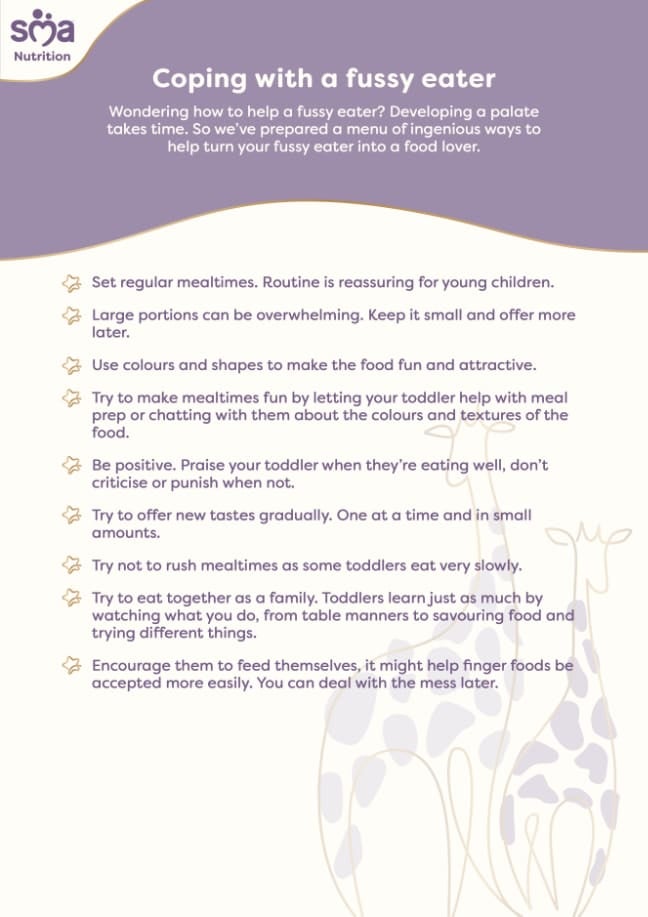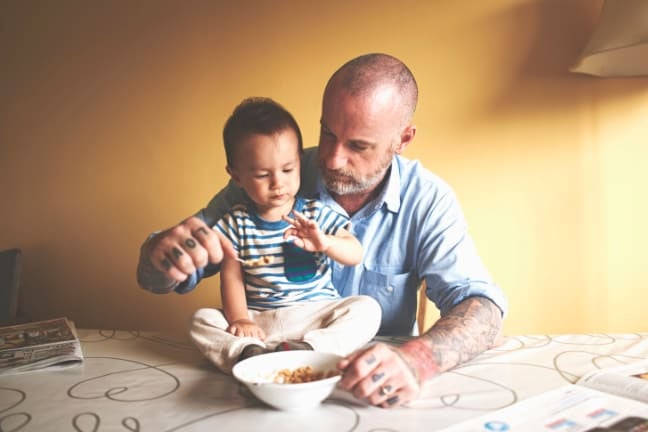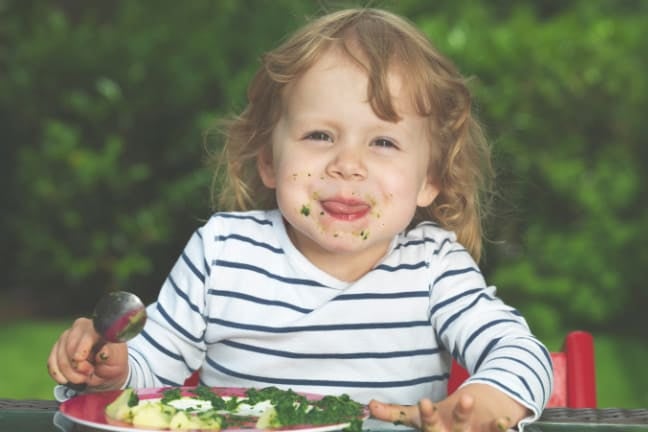Introduction
Almost all toddlers will go through a fussy phase at some point, but stay positive. Praise good eating but try to ignore negative responses. Eating together means you can set good examples and toddlers love to copy!
As long as they are healthy and gaining weight, they’re probably getting enough to eat, so try not to worry. If in doubt, focus on the three Ps of mealtimes: patience, positivity and perseverance. In time your toddler might venture into uncharted food territory all by themselves. We offer top tips for fussy eaters as well as the importance of different food groups.
Top tips for fussy eaters
Set regular mealtimes
Young children find set routines reassuring. It also helps set their body clock for the day. So, their stomachs are ready for their next meal. Not hungry enough or too hungry and you’re more likely to get a negative reaction.
Serve small portions
Large portions can be overwhelming for your toddler. Start with a baby-bear-sized bowl and you can always top them up if they’re hungry for more. Here’s a handy visual portion guide for children from 12 months.
Make food toddler-friendly
Cut sandwiches into fun shapes, arrange things into pictures on a plate (faces, trains, cats) serve fruit in ready-to-eat, bite-sized pieces, or puree and freeze it into ice lolly moulds. We all eat with our eyes first.
Make food fun for fussy toddlers
Let your toddler help in the kitchen. They might like dressing up as a mini masterchef or a little star baker - with their very own equipment, apron and chef hat. Talk to them about the different colour, shapes and textures of the food and get them to show off what they’ve made to the family.
Be positive
Ignore fussiness and praise good eating, even if it’s only a little bit. Flying florets may still take off now and again but if your toddler doesn’t get a big reaction, they may well relent and tuck in.
Offer new tastes
Introduce new flavours one at a time, in small amounts. Try offering a new food alongside something your toddler already enjoys – it can make them more willing to give it a try! Don’t worry if a certain food is rejected. Leave it off the menu for a few days and try again.
Preparation is everything
A toddler who refuses cooked carrots might well polish off a bowlful of raw grated ones, so try different options for rejected foods. Just changing how a food is served may make it more appealing.
Take it slow
Some toddlers eat very slowly and rushing could put them off. Try to be patient and go at their pace.
Eat together
Try to eat meals as a family so your toddler understands that mealtimes are for quality time together. It’s a good chance for them to learn from your table manners too.
Keep it casual
Make sure they can see you and the other members of the family enjoying your food. Then they’re more likely to want to join in the food appreciation.
Avoid alternatives to their meal
Offering alternatives when they refuse a meal leads to your toddler expecting this again (and again) next time, and it often means more food waste too. Why not offer them a choice between two food options, It helps them feel more independent.
Be sneaky!
If you’re worried your toddler isn’t getting enough variety, you can sneak fruit and veg into soups, casseroles, pasta sauces and even cakes.
Primary food groups
While you may have mastered the four main food groups at mealtimes, you might find your toddler still isn’t getting any in their mouth.
Never fear, if they’re still fussy or picky eaters at mealtimes you could try and make sure the snacks you offer in between meals are pulling their weight when it comes to nutrients. Ideally offer two healthy snacks a day: one mid-morning and one mid-afternoon. Here are some simple and healthy snack ideas that cover the four main food groups:
Dairy
- Portion of cheese
- Plain yoghurt with fruit
- Milk (cows’, formula, or plant-based)
- Rice pudding (check sugar content)
Starchy
- Toast with smooth peanut or almond butter
- Potato wedges (baked)
- Scone with butter
- Pitta with hummus dip
Fruit & veg
- Fruit faces (raspberry eyes, apple mouth, strawberry nose… you get the idea)
- Apple slices with peanut butter dip
- Veg sticks with blended olive dip (tapenade)
- Plain rice cakes with mashed avocado dip
Protein
- Chopped boiled egg
- Cocktail sausages (check the salt content)
- Dhal dip with warmed naan bread
- Shelled, unsalted edamame beans
We have lots more ideas on what to include in each food group in our article: Healthy diet for toddlers.
What to do when nothing else works?
Consider keeping a diary of the foods and drinks they’re eating over a week. If they’re eating something from each of the four main food groups then you probably shouldn’t worry.
If they’re missing out on a lot of foods then your next port of call is your health visitor or GP. They’ll look at their weight and height. If there is an issue, they’ll be able to help with what to do next.
Dealing with a fussy eating toddler can be challenging and may present you with some interesting challenges. However, with these helpful tips and guide, you can be better equipped to assist your toddler in learning to expand their food preferences and most importantly, enjoying mealtimes (for both of you!) Discover practical ways to encourage healthy eating habits and nurture a love of food by downloading our helpful guide.

Join SMA® Baby Club to receive the Mother of all Checklists. With 63 checklists across your parenting journey from pregnancy through to toddlerhood we have you covered.








